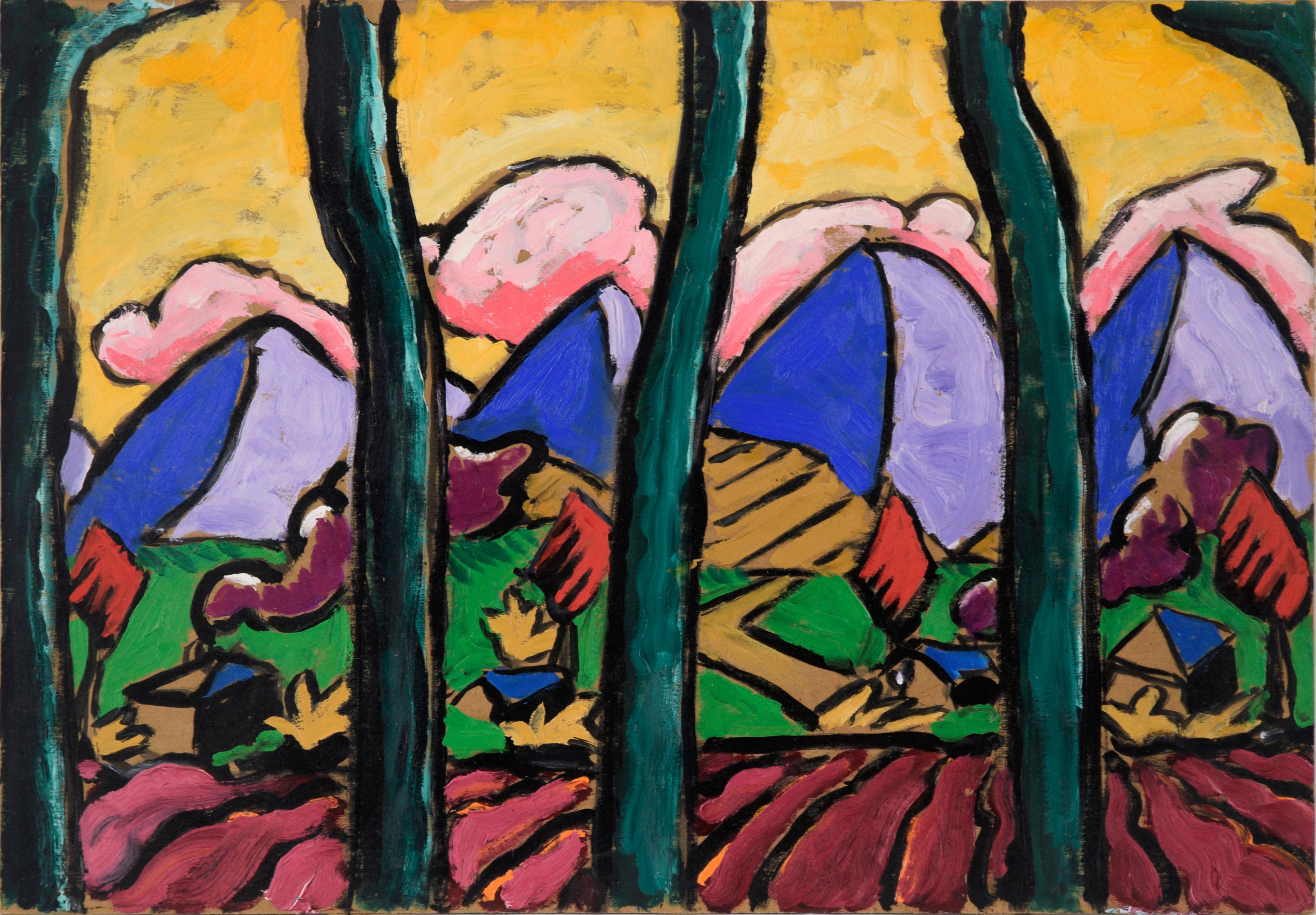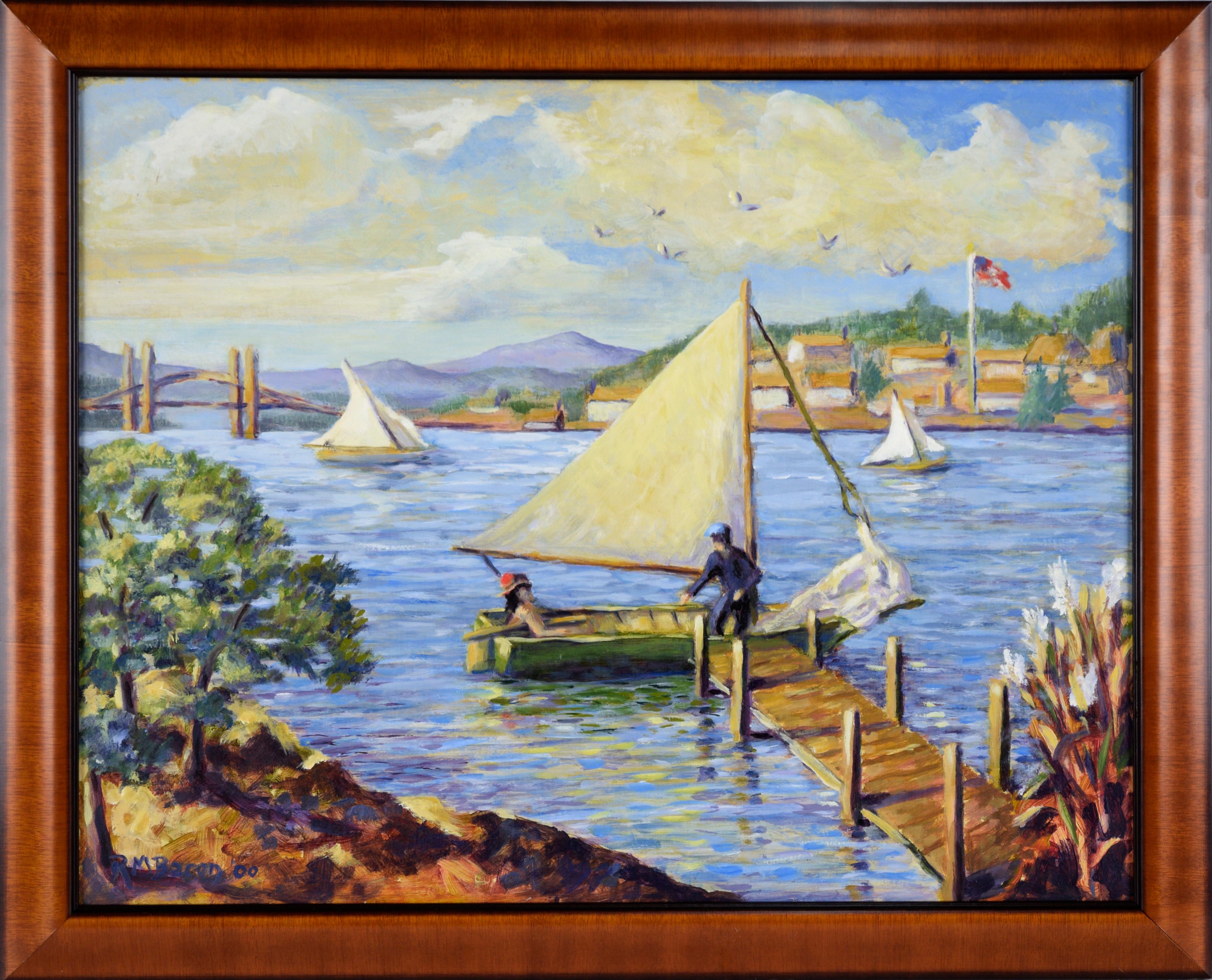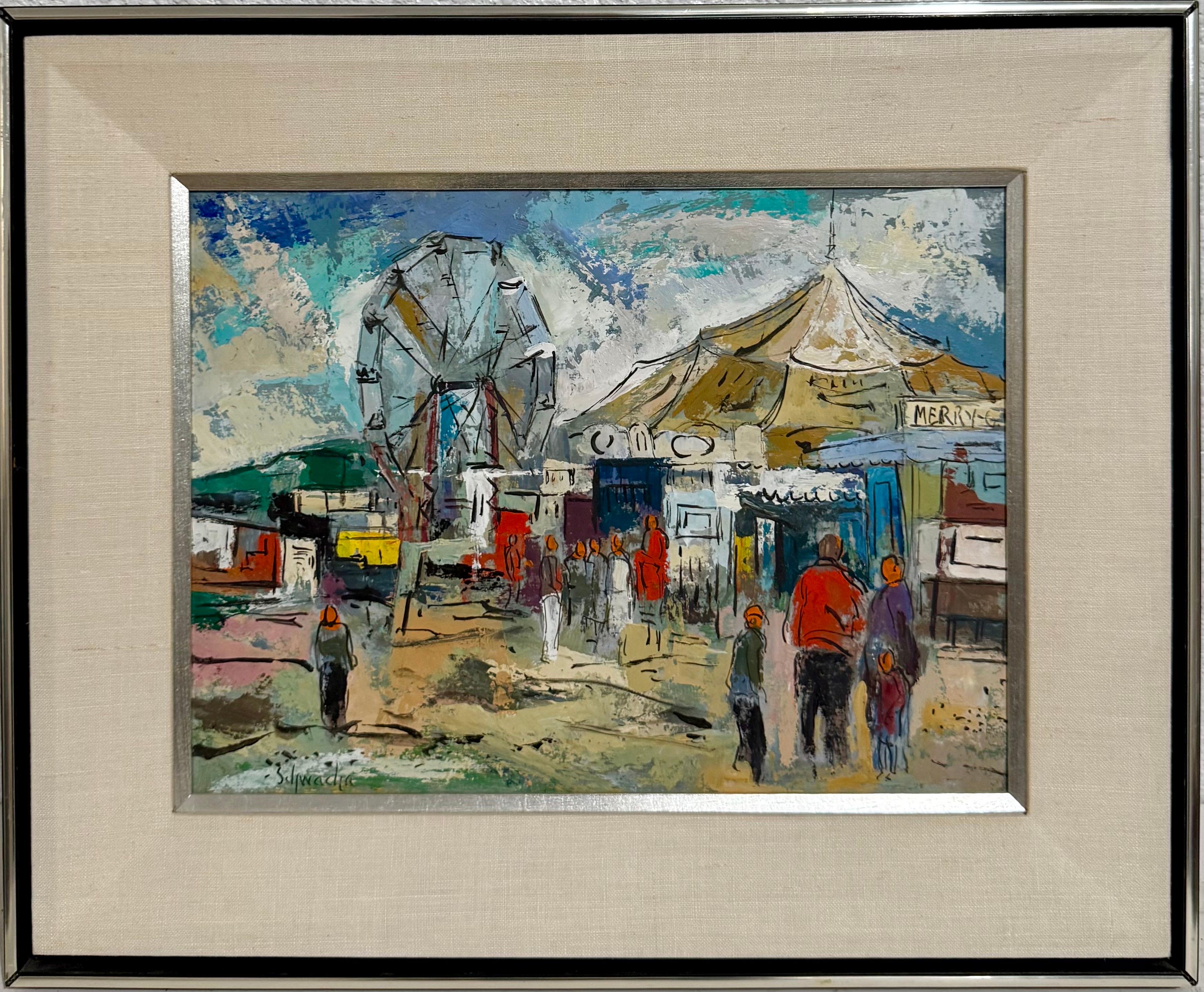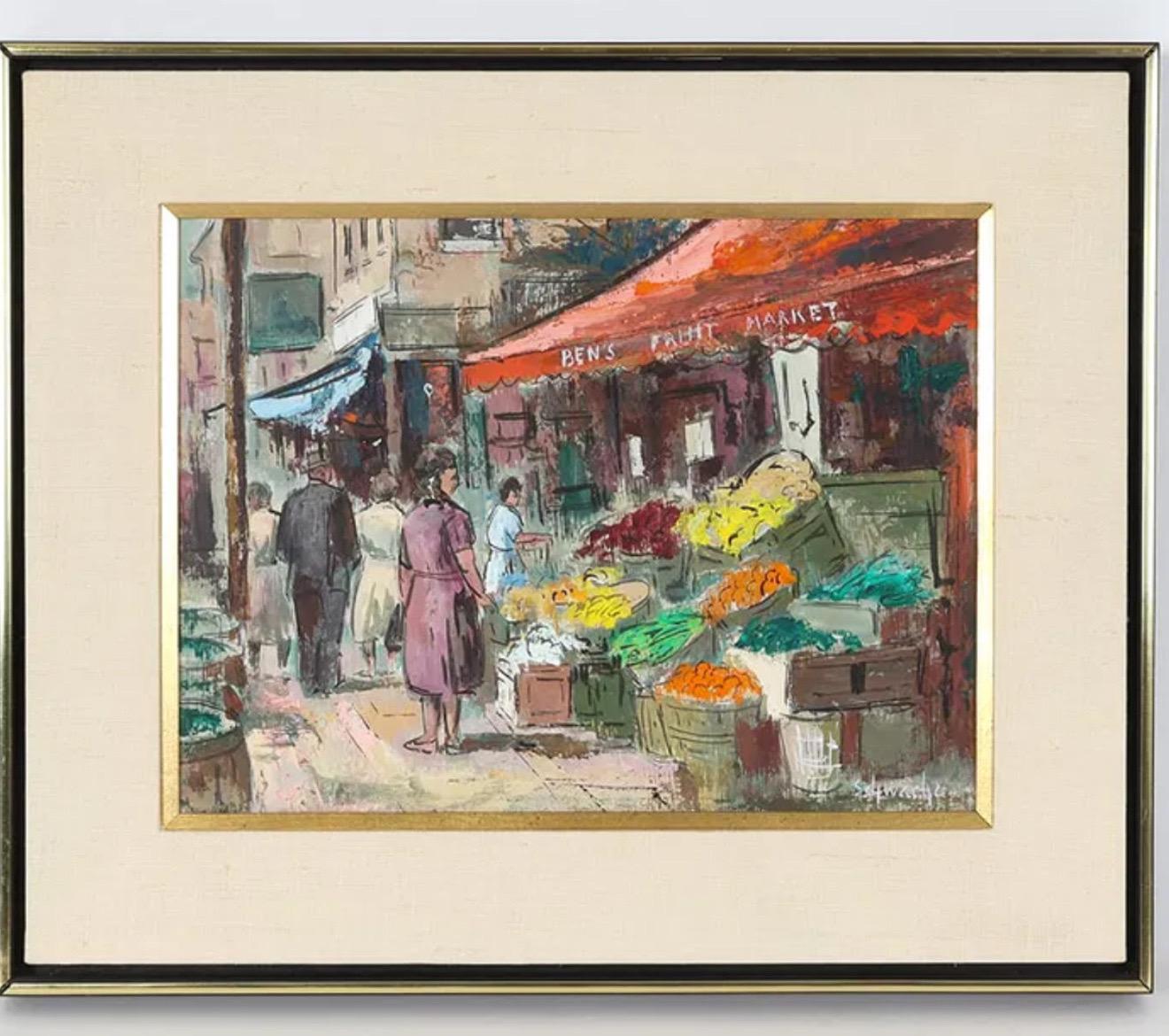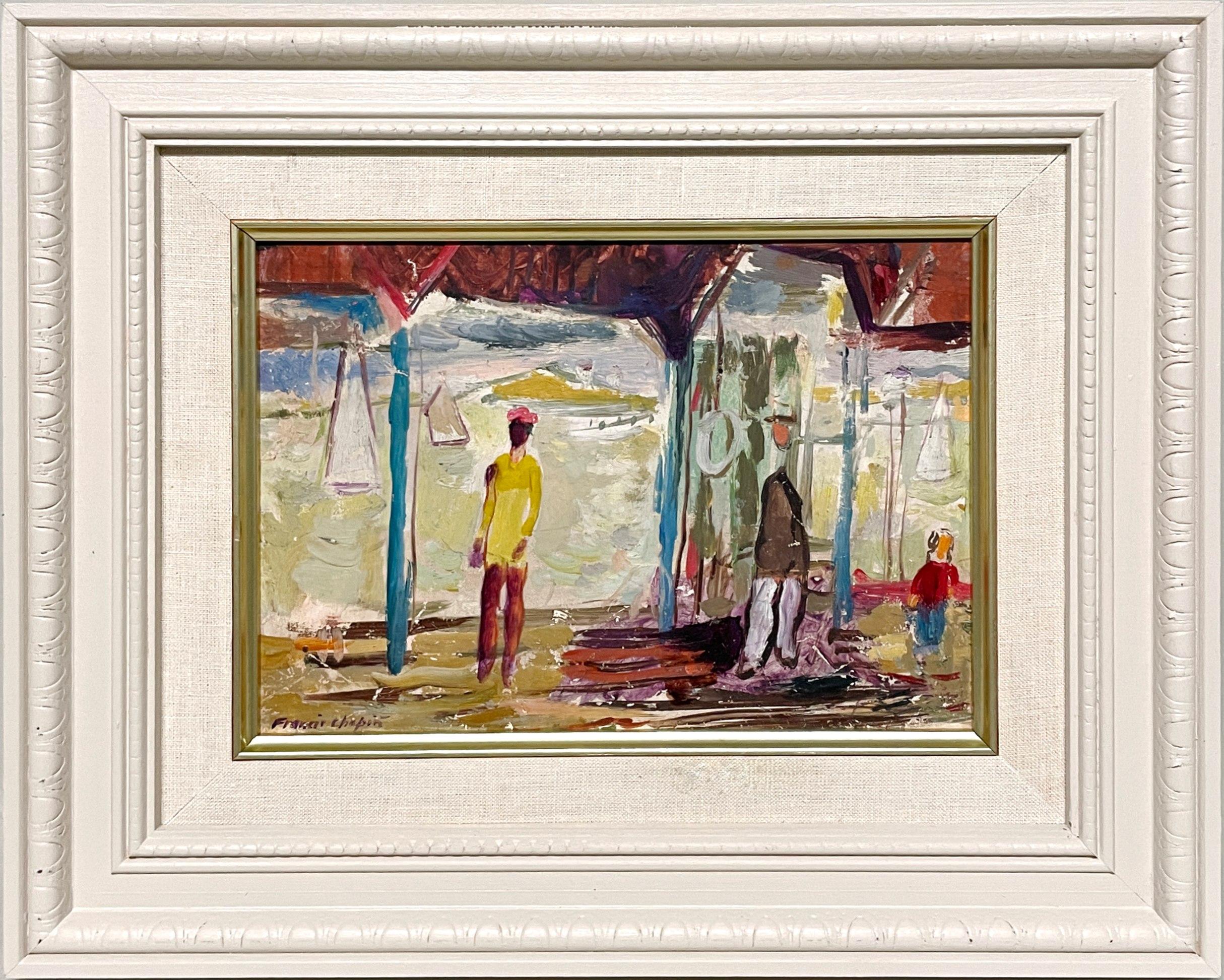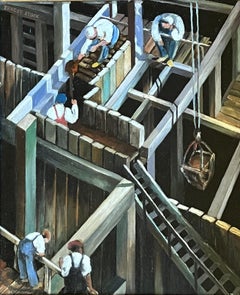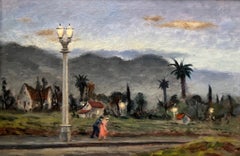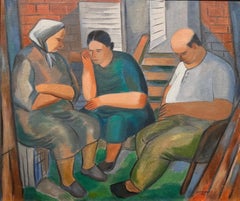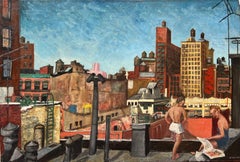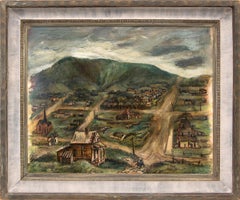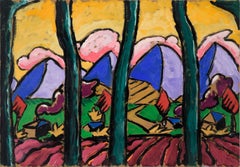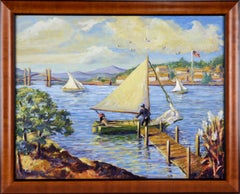Items Similar to Lonely Road (perhaps also known as The Road Home)
Want more images or videos?
Request additional images or videos from the seller
1 of 5
Mildred OlmesLonely Road (perhaps also known as The Road Home)c. 1930s
c. 1930s
$5,750
£4,325.38
€5,010.75
CA$8,106.31
A$9,014.76
CHF 4,730.67
MX$109,930.63
NOK 59,797.31
SEK 56,062.36
DKK 37,399.64
About the Item
Lonely Road (perhaps also known as The Road Home), c. 1930s, oil on Masonite, signed lower right, 20 x 30 inches, label verso reads: “Painted CA. 1930s Oil City, PA Sister to Jo (Yvonne) Allmon,” likely exhibited New Year Show, Butler Art Institute, Youngstown, OH, 1948 (label verso), perhaps exhibited at the 47th Annual Exhibition of American Paintings & Sculpture, Art Institute of Chicago, October 22 – December 6, 1936 (Note: there is a second remnant of an exhibition label verso. The subject matter, style, overall appearance and the date ascribed to this work in the label verso, all suggest this painting was produced in the mid -1930s and likely not around the time of the Butler New Year Show in the late 1940s. Olmes is known to have painted a work entitled The Road Home, which was exhibited at the Art Institute of Chicago and Olmes’ two person exhibition at the Baldwin Museum in 1938 (see Exhibition of Watercolors, The Evening Independent, Massillon, OH, November 15, 1938 – “Typical of her best work is an oil “The Road Home,” which was accepted at the annual exhibition of American paintings at the Chicago Art Institute. This picture was also chose for a traveling exhibit.”). It is possible that this work is the painting known as The Road Home.)
In Lonely Road, Mildred Young Olmes depicts a scene near her hometown of Oil City, Pennsylvania, a historically famous site known as one of the birthplaces of the American oil industry which is reflected in the railroad tanker cars and oil storage tanks in the center of the composition and the refineries in the distant hills. In the foreground, Olmes centers a lonely oil worker heading home after a long day in the oil fields. Edwin L. Drake drilled the first successful commercial oil well in nearby Titusville, Pennsylvania, in 1859. This sparked the Pennsylvania oil rush, and Oil City became a central hub for the burgeoning industry. During the late 19th and early 20th centuries, Oil City thrived as a boomtown, attracting oil barons and speculators, and it became a base of operations for major companies such as Pennzoil, Quaker State, and Wolf’s Head. The city grew around the confluence of Oil Creek and the Allegheny River, making it ideal for shipping oil by barge and later by rail, as depicted in Lonely Road. By the 1920s, a decade before Olmes' painting, the largest part of American oil production had moved west to Texas and Oklahoma, but oil wells in western Pennsylvania continued to pump into the Great Depression providing some measure of economic stability for the region.
Mildred Young Olmes was a painter, printmaker, craftsperson, designer and illustrator. Olmes obtained her art degree from the Carnegie Institute and also studied at the Tyler School of Fine Art in Philadelphia and in Europe at the Royal University for Foreigners in Perugia, Italy and in Paris at the Academie Julian. She spent most of her career working in Pennsylvania and Ohio, where she exhibited frequently at the Carnegie Institute, Canton Art Institute, the Butler Art Institute, the Massillon Museum, the Ohio State Fair, the Akron Art Institute, the Ohio Watercolor Exhibition, the Ohio Drawing Exhibition, and the Ohio Valley Exhibition. She also exhibited at the Paris Salon, the Art Institute of Chicago and the Corcoran Galleries in Washington, DC. She completed murals in Canton, Toledo, West Chester, PA, and Massillon. Olmes’ work is in the collections of the Massillon Museum of Art and the Canton Art Institute. She is listed in Who Was Who in American Art and other standard references.
- Creator:Mildred Olmes (1906 - 1994, American)
- Creation Year:c. 1930s
- Dimensions:Height: 20 in (50.8 cm)Width: 30 in (76.2 cm)Depth: 2 in (5.08 cm)
- More Editions & Sizes:20 x 30 inchesPrice: $5,750
- Medium:
- Movement & Style:
- Period:
- Condition:
- Gallery Location:Los Angeles, CA
- Reference Number:1stDibs: LU1859216793142
About the Seller
5.0
Vetted Professional Seller
Every seller passes strict standards for authenticity and reliability
1stDibs seller since 2022
15 sales on 1stDibs
Typical response time: <1 hour
- ShippingRetrieving quote...Shipping from: Los Angeles, CA
- Return Policy
Authenticity Guarantee
In the unlikely event there’s an issue with an item’s authenticity, contact us within 1 year for a full refund. DetailsMoney-Back Guarantee
If your item is not as described, is damaged in transit, or does not arrive, contact us within 7 days for a full refund. Details24-Hour Cancellation
You have a 24-hour grace period in which to reconsider your purchase, with no questions asked.Vetted Professional Sellers
Our world-class sellers must adhere to strict standards for service and quality, maintaining the integrity of our listings.Price-Match Guarantee
If you find that a seller listed the same item for a lower price elsewhere, we’ll match it.Trusted Global Delivery
Our best-in-class carrier network provides specialized shipping options worldwide, including custom delivery.More From This Seller
View AllSubway Construction
Located in Los Angeles, CA
This painting is part of our exhibition American Coast to Coast: Artists of the 1930s
Subway Construction, c. 1928, oil on board, 19 x 15 ¾ inches, signed upper left, artist and title verso; exhibited: 1) 12th Annual Exhibition of the Society of Independent Artists, The Waldorf Astoria, New York NY, from March 9 to April 1, 1928, no. 864 (original price $250) (see Death Prevailing Theme of Artists in Weird Exhibits, The Gazette (Montreal, Quebec, Canada), March 8, 1928); 2) Boston Tercentenary Exhibition Fine Arts and Crafts Exhibition, Horticultural Hall, Boston MA, July, 1930, no. 108 (honorable mention - noted verso); 3) 38th Annual Exhibition of American Art, Cincinnati Art Museum, Cincinnati, OH, June, 1931 (see Alexander, Mary, The Week in Art Circles, The Cincinnati Enquirer, June 7, 1931); and 4) National Art Week Exhibition [Group Show], Montross Gallery, New York, New York, December, 1940 (see Devree, Howard, Brief Comment on Some Recently Opened Exhibitions in the Galleries, The New York Times, December 1, 1940)
About the Painting
Ernest Stock’s Subway Construction depicts the excavation of New York’s 8th Avenue line, which was the first completed section of the city-operated Independent Subway System (IND). The groundbreaking ceremony was in 1925, but the line did not open until 1932, placing Stock’s painting in the middle of the construction effort. The 8th Avenue line was primarily constructed using the “cut and cover” method in which the streets above the line were dug up, infrastructure was built from the surface level down, the resulting holes were filled, and the streets reconstructed. While many artists of the 1920s were fascinated with the upward thrust of New York’s exploding skyline as architects and developers sought to erect ever higher buildings, Stock turned his attention to the engineering marvels which were taking place below ground. In Subway Construction, Stock depicts workers removing the earth beneath the street and building scaffolding and other support structures to allow concrete to be poured. Light and shadow fall across the x-shaped grid pattern formed by the wooden beams and planks. It is no surprise that critics reviewing the painting commented on Stock’s use of an “interesting pattern” to form a painting that is “clever and well designed.”
About the Artist
Ernest Richard Stock was an award-winning painter, print maker, muralist, and commercial artist. He was born in Bristol, England and was educated at the prestigious Bristol Grammar School. During World War I, Stock joined the British Royal Air Flying Corps in Canada and served in France as a pilot where he was wounded. After the war, he immigrated to the United States and joined the firm of Mack, Jenny, and Tyler, where he further honed his architectural and decorative painting skills. During the 1920s, Stock often traveled back and forth between the US and Europe. He was twice married, including to the American author, Katherine Anne Porter. Starting in the mid-1920s, Stock began to exhibit his artwork professionally, including at London’s Beaux Arts Gallery, the Society of Independent Artists, the Salons of America, the Cincinnati Art Museum, the Whitney Studio and various locations in the Northeast. Critics often praised the strong design sensibility in Stock’s paintings. Stock was a commercial illustrator for a handful of published books and during World War II, he worked in the Stratford Connecticut...
Category
1920s American Modern Figurative Paintings
Materials
Oil
Six O'Clock
Located in Los Angeles, CA
Six O-Clock, c. 1942, oil on canvas, 30 x 20 inches, signed and titled several times verso of frame and stretcher (perhaps by another hand), marked “Rehn” several times on frame (for the Frank K. M. Rehn Galleries in New York City, who represented Craig at the time); Exhibited: 1) 18th Biennial Exhibition of Contemporary American Oil Paintings from March 21 to May 2, 1943 at The Corcoran Gallery of Art in Washington, D.C. #87, original price $450 (per catalog) (exhibition label verso), 2) Craig’s one-man show at the Frank K. M. Rehn Galleries, New York City, from October 26 to November 14, 1942, #10 (original price listed as $350); and 3) Exhibition of thirty paintings sponsored by the Harrisburg Art Association at the State Museum of Pennsylvania in Harrisburg in March, 1944 (concerning this exhibit, Penelope Redd of The Evening News (Harrisburg, Pennsylvania) wrote: “Other paintings that have overtones of superrealism inherent in the subjects include Tom Craig’s California nocturne, ‘Six O’Clock,’ two figures moving through the twilight . . . .” March 6, 1944, p. 13); another label verso from The Museum of Art of Toledo (Ohio): original frame: Provenance includes George Stern Gallery, Los Angeles, CA
About the Painting
Long before Chris Burden’s iconic installation outside of the Los Angeles County Museum of Art, Urban Light, another artist, Tom Craig, made Southern California streetlights the subject of one of his early 1940s paintings. Consisting of dozens of recycled streetlights from the 1920s and 1930s forming a classical colonnade at the museum’s entrance, Burden’s Urban Light has become a symbol of Los Angeles. For Burden, the streetlights represent what constitutes an advanced society, something “safe after dark and beautiful to behold.” It seems that Craig is playing on the same theme in Six O-Clock. Although we see two hunched figures trudging along the sidewalk at the end of a long day, the real stars of this painting are the streetlights which brighten the twilight and silhouette another iconic symbol of Los Angeles, the palm trees in the distance. Mountains in the background and the distant view of a suburban neighborhood join the streetlights and palm trees as classic subject matter for a California Scene painting, but Craig gives us a twist by depicting the scene not as a sun-drenched natural expanse. Rather, Craig uses thin layers of oil paint, mimicking the watercolor technique for which he is most famous, to show us the twinkling beauty of manmade light and the safety it affords. Although Southern California is a land of natural wonders, the interventions of humanity are already everywhere in Los Angeles and as one critic noted, the resulting painting has an air of “superrealism.”
About the Artist
Thomas Theodore Craig was a well-known fixture in the Southern California art scene. He was born in Upland California. Craig graduated with a degree in botany from Pomona College and studied painting at Pamona and the Chouinard Art School with Stanton MacDonald-Wright and Barse Miller among others. He became close friends with fellow artist Milford Zornes...
Category
1940s American Modern Landscape Paintings
Materials
Canvas, Oil
$12,500
Neighbors
By Norman Barr
Located in Los Angeles, CA
Neighbors, 1939, oil on canvas, signed and dated lower right, 22 x 26 inches
Norman Barr was an American Scene painter and muralist known for his poignant depictions of working-clas...
Category
1930s American Modern Figurative Paintings
Materials
Canvas, Oil
Rooftop Bathers (Untitled)
Located in Los Angeles, CA
Rooftop Bathers (Untitled), c. 1940s, oil on canvas, 22 x 32 inches, signed lower right
Betty Waldo Parish gives us a delightful slice of life in 1940s New York, as we see a coupl...
Category
1940s American Modern Figurative Paintings
Materials
Canvas, Oil
RFD#1
By Dale Nichols
Located in Los Angeles, CA
RFD #1, 1937, oil on canvas, signed and dated lower right, titled verso, 24 x 30 inches
Iowa had Grant Wood. Missouri had Thomas Hart Benton. Kansas had John Steuart Curry. And, Neb...
Category
1930s American Modern Landscape Paintings
Materials
Canvas, Oil
$75,000
The Gas Station
By Robert Gilbert
Located in Los Angeles, CA
The Gas Station, c. 1930s, oil on canvas, signed lower left, 25 x 20 inches; presented in newer frame
The Gas Station is a rare Southern California urban scene from the Great Depres...
Category
1930s American Modern Figurative Paintings
Materials
Canvas, Oil
You May Also Like
Martyl Schweig 1942 Oil Painting, Victor, Colorado, Ghost Town Landscape
By Martyl Suzanne Schweig Langsdorf
Located in Denver, CO
This stunning original 1942 oil painting, titled "Victor, Colorado", is by acclaimed American artist Martyl Suzanne Schweig (1918–2013). A vibrant and historically rich landscape, this work captures the abandoned ghost town of Victor, Colorado, set against the majestic backdrop of the Rocky Mountains. Rendered in rich hues of green, gold, and earthy brown, Schweig brings to life the rugged beauty and quiet mystery of Colorado’s once-booming mining towns.
The painting was completed during a plein-air painting trip with noted artist Adolph Dehn...
Category
1940s American Modern Landscape Paintings
Materials
Oil, Masonite
Blue and Purple Mountains 2 - Fauvist Landscape
By Don Klopfer
Located in Soquel, CA
Vibrant and playful landscape by California artist Richard "Don" Klopfer (1920-2009). Signed and dated "R. Klopfer 3.86" on verso. No frame. Board size: 13"H x 19"W
Richard "Don" Kl...
Category
1980s American Modern Landscape Paintings
Materials
Oil, Masonite
$1,072 Sale Price
35% Off
"Setting Off" - Nautical Scene in Oil on Masonite
Located in Soquel, CA
"Setting Off" - Nautical Scene in Oil on Masonite
Original impressionist seascape with sailboat by Richard M. Bacon a New England artist (American, 20th Century). At the end of a do...
Category
Early 2000s American Modern Landscape Paintings
Materials
Masonite, Oil
$1,360 Sale Price
20% Off
Modernist Oil Painting George Schwacha Carnival Circus Big Top Ferris Wheel WPA
By George Schwacha Jr
Located in Surfside, FL
Hand signed lower left corner
Oil on masonite
Dimensions: Frame H 18.25" x W 22.25". Sight H 11.25" x W 15.25
This is a great scene, vintage Americana. Possibly Coney Island in Brooklyn New York City. Done in a mid century modern style with great vibrant colors and loose, adept, brushwork.
George Schwacha, Jr. (1908 - 1986) New Jersey artist.
Known for Landscape painting and snow scenes. He studied Arthur W. Woelfle; John Grabach; Edward Dufner and A. Schweider.
George Schwacha was president of the American Artists Professional League and a past president of the Audubon Artists and Art Center of New Jersey. He belongs to the American Watercolor Society, The National Society of Painters in Casein, and the Philadelphia Watercolor Club. His paintings have been shown throughout the country at museums such as the Pennsylvania Academy, the Corcoran Gallery in Washington, DC and the Birmingham Art Museum, The Butler Art Institute in Youngstown, Ohio the Connecticut Academy of Fine Arts, as well as in leading New Jersey and New York exhibitions, including the American Society of Arts and Letters. He is listed in Who's Who in American Art and International Directory of Arts.
His work is represented nationally in over 30 museums and public collections including the Newark Museum, Montclair Museum, Birmingham Art Museum, the Isaac Delgado Museum in New Orleans, and the Butler Art Institute. Worldwide he is also represented in collections in the following countries: Austria, Belgium, Canada, Egypt, England, France, Germany, Greece, Holland, Hong Kong, Israel, Scotland and Switzerland.
Seymour Zayon, Bertram Hartman, Hugh Campbell, Frank Herbst, Joseph Newman, Theodore Valenkamph, Robert John McClelland, Nicolai S (Nicola) Cikovsky, Ben Benn, George Howell Gay, Robert Brackman, Vernon Wood...
Category
Mid-20th Century American Modern Figurative Paintings
Materials
Masonite, Oil
Modernist Oil Painting George Schwacha Brooklyn Street Scene Fruit Market WPA
By George Schwacha Jr
Located in Surfside, FL
Hand signed lower left corner
Oil on masonite
Dimensions: Frame H 18.25" x W 22.25". Sight H 11.25" x W 15.25
This is a great scene, vintage Americana. Possibly Crown Heights in Brooklyn New York City. Done in a mid century modern style with great vibrant colors and loose, adept, brushwork. Fruit vendor with ladies shopping.
George Schwacha, Jr. (1908 - 1986) New Jersey artist.
Known for Landscape painting and snow scenes. He studied Arthur W. Woelfle; John Grabach; Edward Dufner and A. Schweider.
George Schwacha was president of the American Artists Professional League and a past president of the Audubon Artists and Art Center of New Jersey. He belongs to the American Watercolor Society, The National Society of Painters in Casein, and the Philadelphia Watercolor Club. His paintings have been shown throughout the country at museums such as the Pennsylvania Academy, the Corcoran Gallery in Washington, DC and the Birmingham Art Museum, The Butler Art Institute in Youngstown, Ohio the Connecticut Academy of Fine Arts, as well as in leading New Jersey and New York exhibitions, including the American Society of Arts and Letters. He is listed in Who's Who in American Art and International Directory of Arts.
His work is represented nationally in over 30 museums and public collections including the Newark Museum, Montclair Museum, Birmingham Art Museum, the Isaac Delgado Museum in New Orleans, and the Butler Art Institute. Worldwide he is also represented in collections in the following countries: Austria, Belgium, Canada, Egypt, England, France, Germany, Greece, Holland, Hong Kong, Israel, Scotland and Switzerland.
Seymour Zayon, Bertram Hartman, Hugh Campbell, Frank Herbst, Joseph Newman, Theodore Valenkamph, Robert John McClelland, Nicolai Cikovsky, Ben Benn, George Howell Gay, Robert Brackman, Vernon Wood...
Category
Mid-20th Century American Modern Figurative Paintings
Materials
Masonite, Oil
A Charming, 1950s Mid-Century Modern Harbor Scene of Martha's Vineyard
By Francis Chapin
Located in Chicago, IL
A Charming, Colorful 1950s Mid-Century Modern Harbor Scene of Martha's Vineyard by Notable Chicago Artist, Francis Chapin (Am. 1899-1965). Painted near the artist's studio and summe...
Category
Mid-20th Century American Modern Landscape Paintings
Materials
Masonite, Oil

